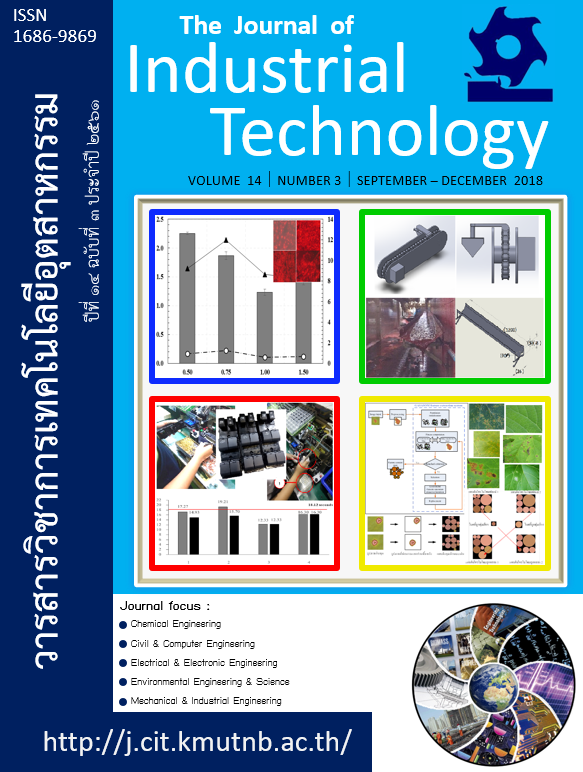(การผลิตพอลิไฮดรอกซีอัลคาโนเอตจากกรดไขมันของน้ำมันปาล์ม โดยใช้เชื้อ Pseudomonas fluorescens TISTR 358)(Polyhydroxyalkanoates Production from Fatty Acids of Palm Oil using Pseudomonas fluorescens TISTR 358)
Keywords:
Polyhydroxyalkanoates, Pseudomonas fluorescens, Palm oil, Fatty acidsAbstract
This study aimed to investigate the production of polyhydroxyalkanoates (PHAs) from fatty acids of saponified palm oil as a carbon source using Pseudomonas fluorescens TISTR 358. The batch experiments were setup in an incubator shaker with 180 rpm at 30ºC. Varying the concentrations of fatty acids including 0.50, 0.75, 1.00 and 1.50% (w/v), respectively and initial pH 7.0. The results showed that the concentrations of carbon sources influenced cell growth, pH and the PHAs production. The maximum of cell dry weight were 1.63, 1.60, 1.08 and 1.05 g L-1 which were observed in fatty acids concentrations of 0.50, 0.75, 1.00 and 1.50% (w/v), respectively at 48 hrs incubation. The highest PHAs content after 72 hrs incubation was 12.61% (0.17 g L-1) of fatty acids concentrations was 0.50% (w/v). The microbial cells showed high red fluorescent, when the cells were determined using the fluorescent dye Nile red and the PHAs granule of intracellular the microbial cell were seen by transmission electron microscope. The results indicated that P. fluorescens TISTR 358 could produce PHAs in an intracellular by using fatty acids from palm oil.
References
[2] S. Phol-in, “Screening and Production of Poly-Beta-hydroxybutyrate (PHB) by Marine Microorganism”, Master Thesis, Department of Biotechnology, Silpakorn University, Thailand, 2011.
[3] P. Pornchaloempong, “Palm Oil”, Available: http://www.foodnetworksolution.com, August 2013. (in Thai)
[4] S.R. Silva-Queiroz, L.F. Silva, J.G.C. Pradella, E.M. Pereira and J.G.C. Gomez. “PHAMCL biosynthesis systems in Pseudomonas aeruginosa and Pseudomonas putida strains show differences on monomer specificities”, Journal of Biotechnology 143(2), 2009, pp. 111-118.
[5] R.F. Gamal, H.M. Abdelhady, E.A. Hassan, T.S. El-Tayeb and K.A. Aboutaleb, “Production of PHAsn from waste frying oil by Pseudomonas fluorescens S48 using different bioreactor feeding strategies”, Egypt Journal Microbiology, 2012.
[6] I.K.P. Tan, K.S. Kumar, M. Theanmalar, S.N. Gan and B. Gordon, “Saponified palm kernel oil and its major free fatty acids as carbon substrates for the production of polyhydroxyalkanoates in Pseudomonas putida PGA1”, Applied Microbiology and Biotechnology 47(3), 1997, pp. 207-211.
[7] J. Snoei, “Fatty acid as an alternative carbon source for MCL-polyhydroxyalanoate production by Pseudomonas Fluorescens SC4 Laboratory of Polymer Technology”, International Journal of Latest Research in Science and Technology ISSN 4, 2015.
[8] American Public Health Association, American Water Works Association, “Water Pollution Control Federatiom, Standard methods for the examination of water and wastewater (20th Eds.)”, American Public Health Association, Washington DC, 1998.
[9] S. Vatanyoopaisarn, P. Kaothien and R. Chongcharoen, “Laboratory Manual for General Microbiology (2nd Eds.)”, King Mongkut’s University of Technology North Bangkok, Bangkok, Thailand, 2006, pp. 13-17.
[10] R. Chongcharoen, “Production of poly-3-hydroxyalkanoate from cheap renewable carbon sources”, Science and Technology Research Institute, King Mongkut’s University of Technology North Bangkok, 2009. (in Thai)
[11] E. Grothe, M. Moo-Young and Y. Christi, “Fermentation optimization for production of Poly (β-hydroxybutyric acid) microbial thermoplastic”, Enzyme Microb Technology 25, 1999, pp. 132-141.
[12] Y.J. Chen, Y.C. Huang and C.Y. Lee, “Production and characterization of medium-chain-length polyhydroxyalkanoates by Pseudomonas mosselii TO7”, Journal of Bioscience and Bioengineering 118(2), 2014, pp. 145-152.
[13] R.F. Gamal, H.M. Abdelhady, E.A. Hassan, T.S. El-Tayeb and K.A. Aboutaleb, “Production of PHAs from waste frying oil by Pseudomonas fluorescens S48 using different bioreactor feeding strategies”, Egypt Jouanal Microbiology 47(1), 2012, pp.1-15.
[14] P. Kahar, T. Tsuge, K. Taguchi and Y. Doi, “High yield production of polyhydroxyalkanoates from soybean oil by Ralstonia eutropha and its recombinant strain”, Polymer Degradation and Stability 83(1), 2004, pp. 79-86.
[15] W. Sengpracha, M.B. Agustin and W. Phutdhawong, “A Survey on the Fatty Acid Composition of Commercial Palm Oil in Thailand”, Chemical Science Transactions 1(3), 2012, pp. 612-617.
[16] S. Kanchanasuta, “Utilization of Cassava Pulp and Rice Straw as Feed Stocks for Production of Polyhydroxyalkanoate Bioplastics and Biological Hydrogen Production from Palm Thesis, Department of Environmental Technology, King Mongkut’s University of Technology North Bangkok, Thailand. 2008.


